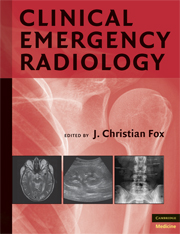Book contents
- Frontmatter
- Contents
- Contributors
- PART I PLAIN RADIOGRAPHY
- 1 Plain Radiography of the Upper Extremity in Adults
- 2 Lower Extremity Plain Radiography
- 3 Chest Radiograph
- 4 Plain Film Evaluation of the Abdomen
- 5 Plain Radiography of the Cervical Spine
- 6 Thoracolumbar Spine and Pelvis Plain Radiography
- 7 Plain Radiography of the Pediatric Extremity
- 8 Plain Radiographs of the Pediatric Chest
- 9 Plain Film Radiographs of the Pediatric Abdomen
- 10 Plain Radiography in Child Abuse
- 11 Plain Radiography in the Elderly
- PART II ULTRASOUND
- PART III COMPUTED TOMOGRAPHY
- PART IV MAGNETIC RESONANCE IMAGING
- Index
- Plate Section
5 - Plain Radiography of the Cervical Spine
from PART I - PLAIN RADIOGRAPHY
Published online by Cambridge University Press: 07 December 2009
- Frontmatter
- Contents
- Contributors
- PART I PLAIN RADIOGRAPHY
- 1 Plain Radiography of the Upper Extremity in Adults
- 2 Lower Extremity Plain Radiography
- 3 Chest Radiograph
- 4 Plain Film Evaluation of the Abdomen
- 5 Plain Radiography of the Cervical Spine
- 6 Thoracolumbar Spine and Pelvis Plain Radiography
- 7 Plain Radiography of the Pediatric Extremity
- 8 Plain Radiographs of the Pediatric Chest
- 9 Plain Film Radiographs of the Pediatric Abdomen
- 10 Plain Radiography in Child Abuse
- 11 Plain Radiography in the Elderly
- PART II ULTRASOUND
- PART III COMPUTED TOMOGRAPHY
- PART IV MAGNETIC RESONANCE IMAGING
- Index
- Plate Section
Summary
OVERVIEW AND CAPABILITIES
By conservative estimates, more than 1 million patients present to U.S. EDs each year with potential cervical spine (C-spine) injury, prompting approximately 800,000 C-spine radiographs. Injuries occur most often in motor vehicle crashes (MVCs), during sports and recreational activities, and with falls.
Throughout the years, clinical observational and biophysical laboratory studies have reinforced the idea that patterns of C-spine injury can be closely correlated with mechanism of injury (MOI; e.g., hyperflexion, rotation, axial compression), and thus, most modern texts classify the injuries into categories based on MOI. This can aid the emergency physician or radiologist in interpreting the radiographs or support the decision for further evaluation in cases of ambiguous or negative results in the setting of a significant MOI.
In blunt trauma, C5 through C7 are the most commonly injured vertebrae, followed closely by C2. This applies to both fractures and dislocations or subluxations caused by soft tissue compromise (1). It is important to bear in mind that up to 25% of patients with one C-spine injury have multiple injuries, (2) so identification of a stable or clinically unimportant injury should not preclude the possibility of a more severe one.
Questions of who should be imaged, to what extent, and with which modality have been proposed and studied thoroughly in the past decade.
Keywords
- Type
- Chapter
- Information
- Clinical Emergency Radiology , pp. 91 - 105Publisher: Cambridge University PressPrint publication year: 2008

